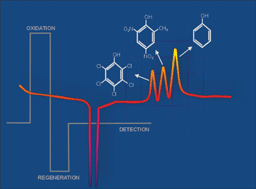Pulsed amperometric detection with poly(dimethylsiloxane)-fabricated capillary electrophoresis microchips for the determination of EPA priority pollutants
Abstract
A miniaturized analytical system for separation and detection of three EPA priority phenolic pollutants, based on a poly(dimethylsiloxane)-fabricated capillary electrophoresis microchip and pulsed amperometric detection is described. The approach offers a rapid (less than 2 min), simultaneous measurement of three phenolic pollutants: phenol, 4,6-dinitro-o-cresol and pentachlorophenol. The highly stable response (RSD = 6.1%) observed for repetitive injections (n > 100) reflects the effectiveness of Au working electrode cleaned by pulsed amperometric detection. The effect of solution conditions, separation potential and detection waveform were optimized for both the separation and detection of phenols. Under the optimum conditions (5.0 mM phosphate buffer pH = 12.4, detection potential: 0.7 V, separation potential: 1200 V, injection time: 10 s) the baseline separation of the three selected compounds was achieved. Limits of detection of 2.2 µM (2.8 fmol), 0.9 µM (1.1 fmol), and 1.3 µM (1.6 fmol) were achieved for phenol, 4,6-dinitro-o-cresol and pentachlorophenol, respectively. A local city water sample and two over-the-counter sore-throat medicines were analyzed in order to demonstrate the capabilities of the proposed technique to face real applications.


 Please wait while we load your content...
Please wait while we load your content...